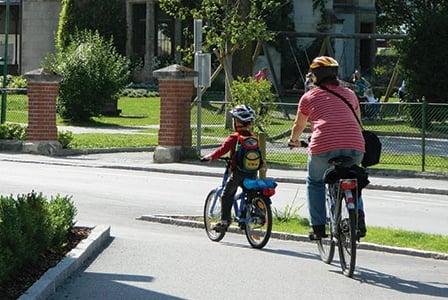
Walking our kids to school isn\’t just healthy and social, but also benefits the environment.
Do you want to do your part for the environment by reducing emissions, while enjoying health benefits and a time to connect with loved ones? Active transportation—the practice of leaving the car at home and instead using our own power to get to local destinations—can do all that.
Fit kids—and parents!
Physical activities such as walking and wheeling help us develop and maintain cardiovascular fitness, strength, flexibility, and bone density. These activities also have a positive impact on mental health including self-concept, anxiety, and depression.
Getting out and about is particularly important for children and adolescents, whose bodies are still developing, as 90 percent of our total bone mass is formed by the time we reach adulthood.
Social ties
A not so obvious perk to active transportation is the time it allows us to connect with others. Cycling and “footing it” with family members is a chance to further nurture our relationships.
Carolyn Conrad walks her daughter, 10-year-old Natalia, to and from school every day. “Walking home, she’ll talk about things that happened; little bits of the day might come out in an unplanned way. She’ll talk about life, things she has seen,” Conrad says.
Beyond being a great chance to swap cheerful stories, these connections cultivate strong social ties that can have a positive mental and physical impact on both adults and children. In adults, it may help manage stress and anxiety, and has been linked to less inflammation and even a reduced risk of some forms of cancer. In children, social connectedness can help boost self-esteem and encourage interaction with new and exciting environments.
Social connections are particularly important for children’s social and emotional development—their ability to sort out conflicts, manage and understand feelings, and develop sympathy for others.
Conrad gives an example: “We were walking by a bus shelter and Natalia saw a woman who she thought looked sad and troubled. There’s empathy and compassion developing there.”
Linger on
Catherine O’Brien, PhD, associate professor at Cape Breton University, has been researching children’s views on transportation for more than 14 years in different capacities. She describes active transportation as helping to “preserve a culture of childhood.”
Instead of being absorbed into the views of transportation that many adults hold—getting place to place as quickly as possible—kids can discover, explore, and find joy in their newfound knowledge when they walk or cycle to school, home, or wherever they may be headed.
“Walking allows children to experience the world in a lingering way, rather than being tied to adult schedules,” O’Brien says.
A question of happiness
Active transportation also works hand in hand with a concept that O’Brien has coined “sustainable happiness,” which takes place when we achieve happiness that doesn’t come at the expense of others or the environment.
This concept underscores the connection between sustainability and happiness, drawing attention to the fact that our happiness and well-being are intertwined with other people and the natural environment.
O’Brien’s most recent research focuses on the relationship between active transportation and sustainable happiness. In a survey that asked about the emotional experience of children and parents on the trip to school, she found that “both the children and parents reported more positive emotions if they actively travelled to school.”
Her findings will soon be published in the Journal of School Health.
A step toward better grades
Beyond helping our kids to be their most curious and smiling selves, parking the car and walking or cycling to school may also help them in the classroom.
A recent study found that teenagers who engaged in 12 minutes of exercise scored better on attention and reading tests than their counterparts in a control group, and that these benefits lasted for 45 minutes—or enough time to make it through an early morning English test.
Just walk it!
When it comes to letting kids walk alone, parents most often cite “stranger danger” and fear of abduction as main reasons for driving their kids to school.
While these risks are more perceived than realistic, Jacky Kennedy, Director of Canada Walks, acknowledges that parents cannot address safety concerns about infrastructure and traffic by themselves.
Luckily, parents aren’t alone. Active & Safe Routes to School, “a community effort” that Kennedy helped develop, is a national movement that promotes active transportation as a way for kids to get to and from school. The program uses methods such as the Walking School Bus, where parents take turns walking groups of neighbourhood children to school.
According to Kennedy, walking or cycling is “the only opportunity that you will ever have to teach your children how to be safe in their community, what to look out for, how to deal with different situations. It could even turn you into a community advocate!”
“These kinds of things won’t happen if you don’t ever take a walk with your child,” Kennedy concludes.
Get active!
The 2014 Active Healthy Kids Canada Report Card, which grades the physical activity of children and youth, is out. Although we are leading when it comes to organized sports, built structures (parks, outdoor spaces), well developed policies, and physical education programs, we are lagging behind other countries for overall physical activity.
However, opportunities to stretch our legs are all around us. Instead of driving,
- cycle to the grocery store or next group activity
- in-line skate to a friend or family member’s house
- walk with your kids to their next after-school activity
- organize and participate in a weekend scavenger hunt
International Walk to School Month
International Walk to School Month (IWALK) is a global celebration that takes place each October. Active transportation and its related issues are used to introduce communities to the Active & Safe Routes to School program.
Visit IWALK’s website (iwalktoschool.org) for more information.


